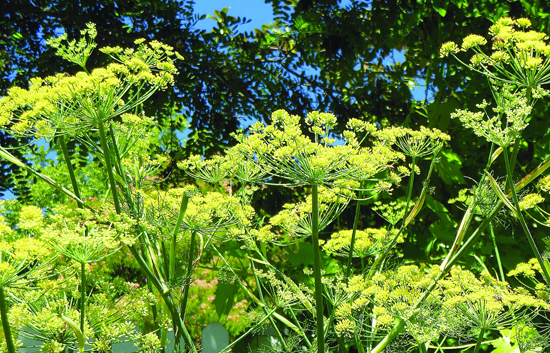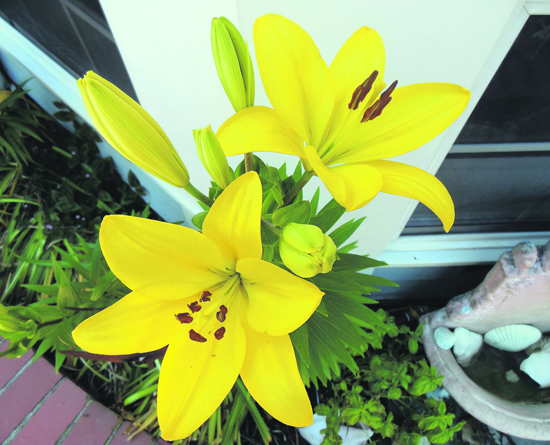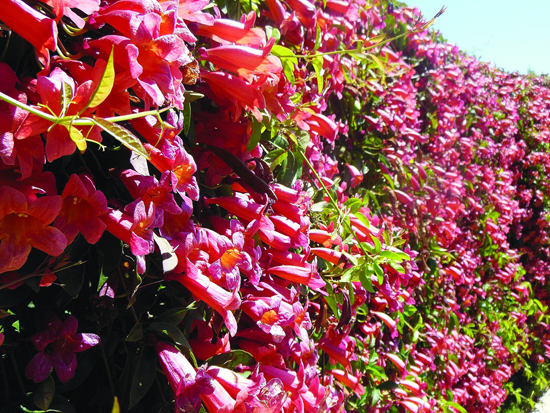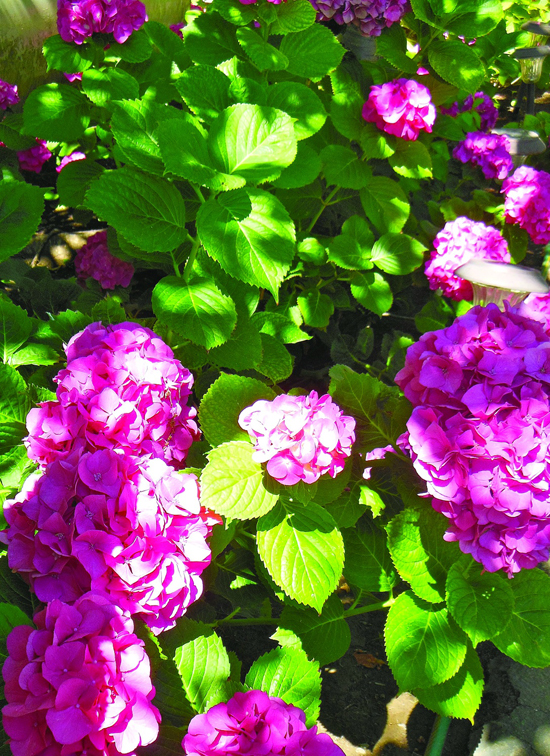 | | | Pink bower vine twines around a pergola. Photos Cynthia Brian
| | | | | |
Like a middle child, July emerges with a bang, fireworks, parades, and the celebration of our American independence. Sandwiched between the end of school, graduation, and Father's Day month of June and the vacation, travel, back-to-school month of August, July must grab our attention swiftly, less it be lost between its frenzied siblings. And capture our interest it does with an abundance of luscious fresh fruits, vegetables, herbs to nurture our bellies, and a profusion of sizzling hot hued plants to seduce our spirits.
 Summer is in full swing in the garden. This is the season of plenty. For a gardener, the shed becomes a playhouse, and shears the tool of choice as we trim, cut, prune, and fill our baskets with food and flowers to share. Containers are overflowing with pretty petunias and spilling lobelia as we welcome our visitors to a party on the patio.
Summer is in full swing in the garden. This is the season of plenty. For a gardener, the shed becomes a playhouse, and shears the tool of choice as we trim, cut, prune, and fill our baskets with food and flowers to share. Containers are overflowing with pretty petunias and spilling lobelia as we welcome our visitors to a party on the patio.
 We witness the bud burst of agapanthus into brilliant blue blooms within days. Gladioli spires shoot for the stars, their cherry throats contrasting spectacularly with the grays of the dusty miller. Honeybees dance on the magnolias, hollyhocks, penstemons, and flowering succulents, sucking the nectar and pollinating surrounding specimens. Fences of scarlet trumpet vine herald the arrival of butterflies and hummingbirds. Asiatic lilies in colors of the rainbow poke their heads above the crowd making sure they are recognized. Hydrangea blooms are as big as beach balls, mandevilla and pink bower vine enliven arbors and pergolas. The garden is alive, vibrant, and waiting to be enjoyed.
We witness the bud burst of agapanthus into brilliant blue blooms within days. Gladioli spires shoot for the stars, their cherry throats contrasting spectacularly with the grays of the dusty miller. Honeybees dance on the magnolias, hollyhocks, penstemons, and flowering succulents, sucking the nectar and pollinating surrounding specimens. Fences of scarlet trumpet vine herald the arrival of butterflies and hummingbirds. Asiatic lilies in colors of the rainbow poke their heads above the crowd making sure they are recognized. Hydrangea blooms are as big as beach balls, mandevilla and pink bower vine enliven arbors and pergolas. The garden is alive, vibrant, and waiting to be enjoyed.
 Like all celebrations, there are always a few inconveniences that need to be addressed. Here are my favorite ways of eliminating the pests.
Like all celebrations, there are always a few inconveniences that need to be addressed. Here are my favorite ways of eliminating the pests.
 Yellow Jackets: If you have yellow jackets plaguing your summer barbecues, you need to follow the yellow flyers back to their nest. Yellow jackets live and hatch in holes in the ground. While it is advised to hang a trap only on the day of your event, contrary to popular belief, the more yellow jacket traps you set, the more yellow jackets you'll have to contend with because when a soldier dies, the Queen doubles her duty to produce more warriors for the colony. The hard part is finding the nest. Once you've located it, instead of buying a spray, call Vector Control. A professional will come free of charge, dress in a bee keeper's suit, and go to work spraying the nest with long hoses to kill the queen. The problem with commercial repellents is that they can't get far enough into the tunnels. When my yellow jacket issue arose, Vector informed me that the underground nest was probably at least thirty feet of winding chambers filled with thousands of yellow jackets.
Yellow Jackets: If you have yellow jackets plaguing your summer barbecues, you need to follow the yellow flyers back to their nest. Yellow jackets live and hatch in holes in the ground. While it is advised to hang a trap only on the day of your event, contrary to popular belief, the more yellow jacket traps you set, the more yellow jackets you'll have to contend with because when a soldier dies, the Queen doubles her duty to produce more warriors for the colony. The hard part is finding the nest. Once you've located it, instead of buying a spray, call Vector Control. A professional will come free of charge, dress in a bee keeper's suit, and go to work spraying the nest with long hoses to kill the queen. The problem with commercial repellents is that they can't get far enough into the tunnels. When my yellow jacket issue arose, Vector informed me that the underground nest was probably at least thirty feet of winding chambers filled with thousands of yellow jackets.
 Mosquitoes: Plant lemongrass, the main repellent ingredient in citronella candles. Crush or dry the leaves, mix with alcohol or oil and apply to your body, clothing, or make a spray for outdoor areas as a deterrent. Set out citronella candles and torches. Buy Dunks for your fountains, which don't hurt wildlife but kill the mosquito larvae, and call Vector Control again to get mosquito fish if you have a pond. The ThermaCell Mosquito Repellent Patio Lantern sold at hardware and home stores is another great resource.
Mosquitoes: Plant lemongrass, the main repellent ingredient in citronella candles. Crush or dry the leaves, mix with alcohol or oil and apply to your body, clothing, or make a spray for outdoor areas as a deterrent. Set out citronella candles and torches. Buy Dunks for your fountains, which don't hurt wildlife but kill the mosquito larvae, and call Vector Control again to get mosquito fish if you have a pond. The ThermaCell Mosquito Repellent Patio Lantern sold at hardware and home stores is another great resource.
 Snails and Slugs: If snails and slugs are munching your seedlings, handpick at night when they are feeding, wrap copper strips around perimeters of the problem area, or trap in pans of beer. Coffee grinds and wood ash are also deterrents. Make sure to remove garden debris and look under rocks and flowerpots. Since they are hermaphroditic, they will fertilize themselves producing 30 to 120 offspring that begin eating the moment they hatch.
Snails and Slugs: If snails and slugs are munching your seedlings, handpick at night when they are feeding, wrap copper strips around perimeters of the problem area, or trap in pans of beer. Coffee grinds and wood ash are also deterrents. Make sure to remove garden debris and look under rocks and flowerpots. Since they are hermaphroditic, they will fertilize themselves producing 30 to 120 offspring that begin eating the moment they hatch.
 With the irritants under control, focus your attention on pleasant summer guests. Quail, robins, finches, and orioles brighten the landscape with their song and their antics. Provide birdbaths, fountains, and feeders to keep them frolicking in your yard. Fill a clay saucer with water for the butterflies and if you have a swimming pool, rescue the bees that attempt a drink but are doomed to drown. Don't confuse bees with yellow jackets. Bees don't hover around food, only yellow jackets do.
With the irritants under control, focus your attention on pleasant summer guests. Quail, robins, finches, and orioles brighten the landscape with their song and their antics. Provide birdbaths, fountains, and feeders to keep them frolicking in your yard. Fill a clay saucer with water for the butterflies and if you have a swimming pool, rescue the bees that attempt a drink but are doomed to drown. Don't confuse bees with yellow jackets. Bees don't hover around food, only yellow jackets do.
 The feast begins in the orchards, potagers, vegetable, and herb gardens. Plums, apricots, peaches, apples, nectarines, and cumquats are at their peak. Berries of many varieties ripen this month including blackberries, elderberries, blueberries, raspberries, fuchsia berries, and strawberries. With the exception of the elderberry, pick and eat straight from the vine or tree or make heavenly pies, smoothies, jams, jellies, and sorbets. Bulb fennel boasts sprays of yellow flowers, tomatoes, peppers, zucchini, and cucumbers are sweet and prolific. Home gardeners are privy to their own customized produce aisle.
The feast begins in the orchards, potagers, vegetable, and herb gardens. Plums, apricots, peaches, apples, nectarines, and cumquats are at their peak. Berries of many varieties ripen this month including blackberries, elderberries, blueberries, raspberries, fuchsia berries, and strawberries. With the exception of the elderberry, pick and eat straight from the vine or tree or make heavenly pies, smoothies, jams, jellies, and sorbets. Bulb fennel boasts sprays of yellow flowers, tomatoes, peppers, zucchini, and cucumbers are sweet and prolific. Home gardeners are privy to their own customized produce aisle.
 The season of plenty is upon us. Stand, salute, and raise the flag. The greatest reward is sharing the treasures from our own soil. A garden is to give. A garden is to grow.
The season of plenty is upon us. Stand, salute, and raise the flag. The greatest reward is sharing the treasures from our own soil. A garden is to give. A garden is to grow.

 Cynthia Brian's Gardening Guide for July
Cynthia Brian's Gardening Guide for July

 "Nature exists to be enjoyed, not controlled." - Alan Cohen
"Nature exists to be enjoyed, not controlled." - Alan Cohen
 We are all witness to the bizarre weather patterns that our planet has experienced in the past few months. As much as we want to be kings of the world, the reality is that Mother Nature is always in charge. While we can do our part to be eco-friendly and sustainable, we also need to prepare our homes, gardens, families, and pets for the unexpected. July is a wonderful time to get up, get out, and get going on a local level whether it be a short jaunt around the neighborhood or a pool party in the backyard. Get in touch with what we have. Be a tourist in your own town. Whatever you do, spend as much time as possible soaking up the nurture of nature. As of a friend of mine exclaimed, "Be it ever so brief, a time in the garden soothes your soul as a sensual experience, and a summer gift."
We are all witness to the bizarre weather patterns that our planet has experienced in the past few months. As much as we want to be kings of the world, the reality is that Mother Nature is always in charge. While we can do our part to be eco-friendly and sustainable, we also need to prepare our homes, gardens, families, and pets for the unexpected. July is a wonderful time to get up, get out, and get going on a local level whether it be a short jaunt around the neighborhood or a pool party in the backyard. Get in touch with what we have. Be a tourist in your own town. Whatever you do, spend as much time as possible soaking up the nurture of nature. As of a friend of mine exclaimed, "Be it ever so brief, a time in the garden soothes your soul as a sensual experience, and a summer gift."

 - UNPLUG from electronic devices for at least 20 minutes per day five days a week and walk in nature. A study of hikers found that they scored 50 percent better on creativity test after spending - UNPLUG from electronic devices for at least 20 minutes per day five days a week and walk in nature. A study of hikers found that they scored 50 percent better on creativity test after spending
 four days in nature disconnected.
four days in nature disconnected.
 - CURSED with a black thumb, check out the Bluetooth-enabled, low-energy, smart sensor that is placed in the soil of a potted plant to beam real-time data of fertilizer, PH levels, sunlight, - CURSED with a black thumb, check out the Bluetooth-enabled, low-energy, smart sensor that is placed in the soil of a potted plant to beam real-time data of fertilizer, PH levels, sunlight,
 humidity, and temperatures to an app on your smartphone. Visit www.parrot.com.
humidity, and temperatures to an app on your smartphone. Visit www.parrot.com.
 - SHADE your hydrangeas or other shade-loving plants by adding concrete into a partially buried terracotta pot to create an umbrella holder. (Submitted by reader Candy Kattenburg) - SHADE your hydrangeas or other shade-loving plants by adding concrete into a partially buried terracotta pot to create an umbrella holder. (Submitted by reader Candy Kattenburg)
 - PICNIC with produce from your garden or farmer's market after a hike at the Lafayette Reservoir or other local trails. - PICNIC with produce from your garden or farmer's market after a hike at the Lafayette Reservoir or other local trails.
 - ADD drama to a drab arrangement with the dangling seed heads of amaranths. In a vase the blooms last 10-14 days. Hang bunches upside down to dry. - ADD drama to a drab arrangement with the dangling seed heads of amaranths. In a vase the blooms last 10-14 days. Hang bunches upside down to dry.
 - PREPARE for fall color by planting the shrubs of barberry, cotoneaster, nandina, and pyracantha or add a dwarf Japanese maple to a container. - PREPARE for fall color by planting the shrubs of barberry, cotoneaster, nandina, and pyracantha or add a dwarf Japanese maple to a container.
 - START thinking about what bulbs you want for next spring. Catalogues are already filled with the newest attractions and will be in nurseries by September. My favorites are the easy-to-grow - START thinking about what bulbs you want for next spring. Catalogues are already filled with the newest attractions and will be in nurseries by September. My favorites are the easy-to-grow
 perennial bulbs like narcissus, wood hyacinth, and freesia, which spread and return year after year in our mild climate.
perennial bulbs like narcissus, wood hyacinth, and freesia, which spread and return year after year in our mild climate.
 - KEEP a bottle of hydrogen peroxide in your gardening kit. When you get pricked by a bramble or cut by a branch, a quick clean up is in order. And don't forget to have your tetanus shot every 10 years. - KEEP a bottle of hydrogen peroxide in your gardening kit. When you get pricked by a bramble or cut by a branch, a quick clean up is in order. And don't forget to have your tetanus shot every 10 years.
 - STAKE tomatoes and tall perennials before they tumble. - STAKE tomatoes and tall perennials before they tumble.
 - REDUCE your mosquito population by empting any vessel with even a few drops of water. If you have a pond, call Vector Control for free mosquito fish, (925) 685-9301. Ask for Felipe. - REDUCE your mosquito population by empting any vessel with even a few drops of water. If you have a pond, call Vector Control for free mosquito fish, (925) 685-9301. Ask for Felipe.
 - CLEAR dry grasses, brush, wood, and other flammable materials as far from your home as possible. Fire season is raging this year. - CLEAR dry grasses, brush, wood, and other flammable materials as far from your home as possible. Fire season is raging this year.
 - CONTINUE the cornucopia of fresh produce through succession planting. Plant pole beans where you had broccoli, peppers where kale grew, replace spinach with eggplant. In addition, - CONTINUE the cornucopia of fresh produce through succession planting. Plant pole beans where you had broccoli, peppers where kale grew, replace spinach with eggplant. In addition,
 every three weeks, sow more seeds of arugula, beets, lettuce, carrots, radishes, edamame, and whatever you consume the most.
every three weeks, sow more seeds of arugula, beets, lettuce, carrots, radishes, edamame, and whatever you consume the most.
 - RAISE the red, white, and blue not only on the Fourth of July. Everyday is Independence Day for those of us fortunate to live in America. Plant a patch of red begonias, white candytuft, and - RAISE the red, white, and blue not only on the Fourth of July. Everyday is Independence Day for those of us fortunate to live in America. Plant a patch of red begonias, white candytuft, and
 blue salvia in honor of our freedom.
blue salvia in honor of our freedom.
 - ENSURE a flush of bloom past Labor Day by planting colorful annuals of cosmos, - ENSURE a flush of bloom past Labor Day by planting colorful annuals of cosmos,
 zinnia, nasturtiums, marigold, and sunflower.
zinnia, nasturtiums, marigold, and sunflower.
 - PINCH the tops of herbs to keep them from bolting or going to seed. The flowers - PINCH the tops of herbs to keep them from bolting or going to seed. The flowers
 are edible, flavorful, and filled with vitamins.
are edible, flavorful, and filled with vitamins.
 - MOW your lawns properly by raising the blades as the weather warms to encourage - MOW your lawns properly by raising the blades as the weather warms to encourage
 deeper roots and green grass.
deeper roots and green grass.
 - MULCH around your shrubs and bushes with a layer of wood chips or shredded - MULCH around your shrubs and bushes with a layer of wood chips or shredded
 bark to conserve water and keep the soil cooler. In your veggie garden, use straw
bark to conserve water and keep the soil cooler. In your veggie garden, use straw
 or decomposed leaves as they decompose faster.
or decomposed leaves as they decompose faster.
 - WASH clothes and shower after working in the yard or hiking in the hills. Check - WASH clothes and shower after working in the yard or hiking in the hills. Check
 yourself for ticks and fleas.
yourself for ticks and fleas.
 - KEEP your houseplants content and flourishing by watering deeply when the soil is - KEEP your houseplants content and flourishing by watering deeply when the soil is
 20 percent dry to the touch. Make sure they have plenty of light, but not direct
20 percent dry to the touch. Make sure they have plenty of light, but not direct
 scorching sunlight. Scan for bugs and if found, spray outside with organic insecticide.
scorching sunlight. Scan for bugs and if found, spray outside with organic insecticide.
 - MUDDLE mint and whip up a refreshing summer cocktail or infuse basil in your - MUDDLE mint and whip up a refreshing summer cocktail or infuse basil in your
 favorite beverage.
favorite beverage.
 - WAVE at your favorite writers and publishers from the Lamorinda Weekly as they - WAVE at your favorite writers and publishers from the Lamorinda Weekly as they
 march in the Orinda Fourth of July Parade.
march in the Orinda Fourth of July Parade.

 Have a blast of a day on the Fourth of July and may the
Have a blast of a day on the Fourth of July and may the
 entire month be filled with fireworks, fun, family, friends,
entire month be filled with fireworks, fun, family, friends,
 and frivolity. Salute the summer season.
and frivolity. Salute the summer season.

 Happy gardening and happy growing to you!
Happy gardening and happy growing to you!

 (c)2013, Cynthia Brian
(c)2013, Cynthia Brian
 The Goddess Gardener
The Goddess Gardener
 Cynthia@goddessgardener.com, www.goddessgardener.com
Cynthia@goddessgardener.com, www.goddessgardener.com
 925-377-7827, Cynthia is available as a speaker and consultant.
925-377-7827, Cynthia is available as a speaker and consultant.

|





